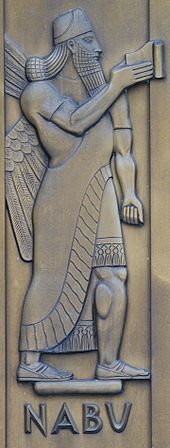Nabu (god)
Nabû ( Akkadian Na-bi-um , Aramaic Nebu = nbw, Nebui = nbwy ) is derived from the Semitic root nb ' ( Nebo ) and is a Babylonian - Assyrian deity. His name means announcer, called one .
Nabu was the god of penmanship and wisdom. In the Babylonian tradition he was also referred to as the "night sun of the underworld" and "bearer of the crown" in Borsippa . As the god of power, he gave the scepter to the kings. He was the son of Marduk and Ṣarpanitu . In the 1st millennium BC His wife was called Tašmetu in Assyria and Nanaja in Babylonia , sometimes Nisaba . Nabu's attribute was the stylus.
cult
His first and for a long time only place of worship was the Babylonian city of Borsippa. There was his sanctuary Ezida and the ziggurat built in his honor . In Borsippa he replaced the former city god Tutu , who was absorbed in Nabu's father Marduk. In Assyria, Nimrud and Nineveh were his cult centers. Under the Neo-Babylonian rulers, Nabu replaced Marduk as cosmic and sometimes even as supreme deity. In Babylon, the coronation took place in the Nabu temple Nabû ša H̆arê, which was therefore called e-nig.gidrukalam.ma-sum.ma ( E-ningidru-kalamma-summtah , house that gives the country the scepter). The temple was renewed by Assurhaddon, as evidenced by a founding cylinder.
Syria
Nabu was one of the oriental deities of Palmyra, spelled Nebo . On some tesserae that were used in the Syrian oasis city in the Greco-Roman times, Nebo and the supreme sky god Bel , the Syrian equivalent of Marduk, are shown together. The connection between the two deities in Palmyra is also likely due to the proximity of the two temples to one another. The Nebo Temple in Palmyra was excavated in 1963/64. The inscriptions found there date between AD 99 and 258/259, but contain little information about the deity. A statuette from Dura Europos shows Nebo with a lyre or writing tablet and a stilus in his hand. With a lyre in his left hand and a pick in his right hand, as shown in a relief by Dura Europos, which bears the name Nabus, he adapts to the Greek Apollo .
Name research
As a theophoric word component, Nabu occurs in personal names. So is Barnabu "son of Nabu" and Nabugaddi "Nabu is my happiness." The widespread use of the Nabu cult is also evident in the use of the name of God for geographical names. Kafr Nabu was the name of a Roman-Early Byzantine place at the height of the Jebel Siman in the north of the northern Syrian limestone massif . As recently as the 13th century, the Arab geographer Yaqut mentions a temple ruin in the abandoned ancient place and calls the entire mountain with its old name Jebel Nabu .
Bible
Nabu is found under the name Nebo in Isaiah 46.1 EU ; Jeremiah 39.3 EU ; Mentioned in the Old Testament of the Bible .
literature
- Helmut Freydank u. a .: Lexicon of the Old Orient. Egypt * India * China * Western Asia . VMA-Verlag, Wiesbaden 1997, ISBN 3-928127-40-3
- Brigitte Groneberg : The gods of the Mesopotamia. Cults, myths, epics . Artemis & Winkler, Stuttgart 2004, ISBN 3-7608-2306-8
- Johannes Pinckert : Hymns and prayers to Nebo (= Leipzig Semitic Studies. Volume 3, Issue 4). Hinrichs, Leipzig 1920. (also dissertation, University of Leipzig, 1907); Unchanged reprint of the edition, Zentralantiquariat der DDR, Leipzig 1968.
- FAM Wiggermann: Nin-gišzida . In: Dietz-Otto Edzard et al. (Hrsg.): Reallexikon der Assyriologie and Near Eastern Archeology . Volume 9: Nab - Nuzi . de Gruyter, Berlin 1998-2001, ISBN 3-11-017296-8 , pp. 368-373.
Individual evidence
- ↑ Nawala al-Mutawalli, A New Foundation Cylinder from the Temple of Nabû ša Hare. Iraq 61, 1999, 191-194
- ↑ Javier Teixidor: The Pantheon of Palmyra. Études préliminaires aux religions orientales dans l'Émpire romain 79. Leiden 1979, pp. 106–110
- ↑ Otto Eißfeldt : Temples and Cults of Syrian Cities in Hellenistic-Roman Times. JC Hinrichs Verlag, Leipzig 1941, pp. 97, 127
- ↑ Teixidor, p. 110
